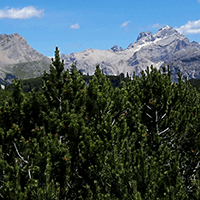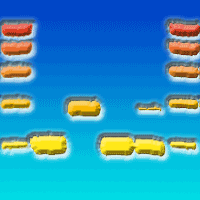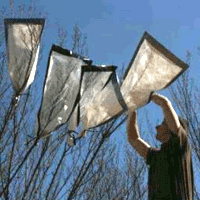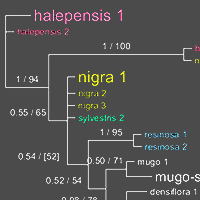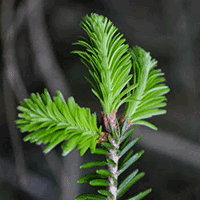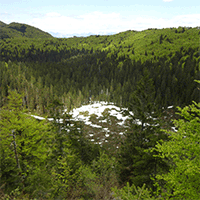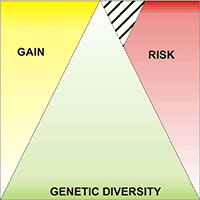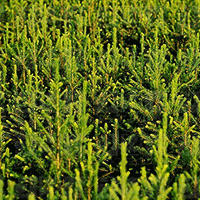Assessing the distribution of chloroplast DNA (cpDNA) haplotype variation is useful for studying the phylogeography of angiosperms. In the last two decades the cpDNA phylogeography of white oaks in Europe has been extensively studied, mostly based on the PCR-RFLP technique. However, PCR-RFLPs have low mutation rates and are primarily useful for reconstructing patterns at large geographical scales and lack resolution at fine spatial scales. Here we evaluate the usefulness of chloroplast microsatellites (cpSSR) as an alternative to PCR-RFLPs in Polish oak populations which have been underrepresented in previous studies. Eighty-five cpSSR haplotypes were detected using 14 cpSSR loci and a broad collection of 6680 trees sampled throughout Poland. Haplotype diversity was significantly lower in Q. petraea (He = 0.798) than in Q. robur (He = 0.820). Only 17 haplotypes (H01-H17) were found in 13 or more individuals, comprising together 97.9% of the sample. Most frequent cpSSR haplotypes were related to PCR-RFLP haplotypes, establishing the cross-references between the two marker systems. There was significant concordance between the matrices of genetic distances obtained by PCR-RFLP haplotypes and cpSSR haplotypes. Phylogenetic relationships among cpSSR haplotypes supported the existence of the three predominant maternal lineages of oaks in Poland: Iberian (7.8%), Apennine (20.6%) and Balkan (65.5%). The results are discussed with regards to the usefulness of cpSSR markers for phylogeographic studies.
Keywords
, , ,
Citation
Chmielewski M, Meyza K, Chybicki IJ, Dzialuk A, Litkowiec M, Burczyk J (2015). Chloroplast microsatellites as a tool for phylogeographic studies: the case of white oaks in Poland. iForest 8: 765-771. - doi: 10.3832/ifor1597-008
Academic Editor
Andrea Piotti
Paper history
Received: Feb 12, 2015
Accepted: Jun 01, 2015
First online: Jul 19, 2015
Publication Date: Dec 01, 2015
Publication Time: 1.60 months
© SISEF - The Italian Society of Silviculture and Forest Ecology 2015
Open Access
This article is distributed under the terms of the Creative Commons Attribution-Non Commercial 4.0 International (https://creativecommons.org/licenses/by-nc/4.0/), which permits unrestricted use, distribution, and reproduction in any medium, provided you give appropriate credit to the original author(s) and the source, provide a link to the Creative Commons license, and indicate if changes were made.

Breakdown by View Type
(Waiting for server response...)
Article Usage
Total Article Views: 52877
(from publication date up to now)
Breakdown by View Type
HTML Page Views: 43037
Abstract Page Views: 4141
PDF Downloads: 4269
Citation/Reference Downloads: 84
XML Downloads: 1346
Web Metrics
Days since publication: 3801
Overall contacts: 52877
Avg. contacts per week: 97.38
Article Citations
Article citations are based on data periodically collected from the Clarivate Web of Science web site
(last update: Mar 2025)
Total number of cites (since 2015): 23
Average cites per year: 2.09
Publication Metrics
by Dimensions ©
Articles citing this article
List of the papers citing this article based on CrossRef Cited-by.
(1)
Bandelt HJ, Forster P, Röhl A (1999)Median-joining networks for inferring intraspecific phylogenies. Molecular Biology and Evolution 16: 37-48.
CrossRef |
Gscholar
(2)
Bordács S, Popescu F, Slade D, Csaikl UM, Lesur I, Borovics A, Kézdy P, König AO, Gömöry D, Brewer S, Burg K, Petit RJ (2002)Chloroplast DNA variation of white oaks in northern Balkans and in the Carpathian Basin. Forest Ecology and Management 156 (1-3): 197-209.
CrossRef |
Gscholar
(3)
Buiteveld J, Koelewijn HP (2006)CpDNA haplotype variation reveals strong human influence on oak stands of the Veluwe forest in the Netherlands. Forest Ecology and Management 228: 160-167.
CrossRef |
Gscholar
(4)
Csaikl UM, Burg K, Fineschi S, König AO, Mátyás G, Petit RJ (2002)Chloroplast DNA variation of white oaks in the alpine region. Forest Ecology and Management 156: 131-145.
CrossRef |
Gscholar
(5)
Degen B, Ward SE, Lemes MR, Navarro C, Cavers S, Sebbenn AM (2013)Verifying the geographic origin of mahogany (
Swietenia macrophylla King) with DNA-fingerprints. Forensic Science International: Genetics 7 (1): 55-62.
CrossRef |
Gscholar
(6)
Deguilloux MF, Dumolin-Lapègue S, Gielly L, Grivet D, Petit RJ (2003)A set of primers for the amplification of chloroplast microsatellites in
Quercus. Molecular Ecology Notes 3: 24-27.
CrossRef |
Gscholar
(7)
Deguilloux MF, Pemonge MH, Petit RJ (2004)Use of chloroplast microsatellites to differentiate oak populations. Annals of Forest Science 61: 825-830.
CrossRef |
Gscholar
(8)
Dering M, Lewandowski A, Ufnalski K, Kedzierska A (2008)How far to the east was the migration of white oaks from the Iberian refugium? Silva Fennica 42 (3): 327-335.
CrossRef |
Gscholar
(9)
Doyle J, Doyle J (1990)Isolation of plant DNA from fresh tissue. Focus 12: 13-15.
Gscholar
(10)
Doyle JJ, Morgante M, Tingey SV, Powell W (1998)Size homoplasy in chloroplast microsatellite of wild perennial relatives of soybean (
Glycine subgenus
Glycine). Molecular Biology and Evolution 15: 215-218.
CrossRef |
Gscholar
(11)
Dumolin-Lapègue S, Demesure B, Fineschi S, Corre VL, Petit RJ (1997)Phylogeographic structure of white oaks throughout the European continent. Genetics 146: 1475-1487.
Online |
Gscholar
(12)
El Mousadik A, Petit RJ (1996)High level of genetic differentiation for allelic richness among populations of the argan tree (
Argania spinosa [L. ] Skeels) endemic to Morocco. Theoretical and Applied Genetics 92: 832-839.
CrossRef |
Gscholar
(13)
Eliades NG, Eliades DG (2009)HAPLOTYPE ANALYSIS: software for analysis of haplotype data. Forest Genetics and Forest Tree Breeding, Georg-August University Goettingen, Germany.
Online |
Gscholar
(14)
Estoup A, Jarne P, Cornuet JM (2002)Homoplasy and mutation model at microsatellite loci and their consequences for population genetics analysis. Molecular Ecology 11: 1591-1604.
CrossRef |
Gscholar
(15)
Fineschi S, Taurchini D, Grossoni P, Petit RJ, Vendramin GG (2002)Chloroplast DNA variation of white oaks in Italy. Forest Ecology and Management 156: 103-114.
CrossRef |
Gscholar
(16)
Gailing O, Wachter H, Heyder J, Schmitt H-P, Finkeldey R (2007a)Chloroplast DNA analysis in oak stands (
Quercus robur L. ) in North Rhine-Westphalia with presumably Slavonian origin: is there an association between geographic origin and bud phenology? Journal of Applied Botany and Food Quality 81: 165-171.
Online |
Gscholar
(17)
Gailing O, Wachter H, Schmitt H-P, Curtu A-L, Finkeldey R (2007b)Characterization of different provenances of Slavonian pedunculate oaks (
Quercus robur L.) in Munsterland (Germany) with chloroplast DNA markers: PCR-RFLPs and chloroplast microsatellites. Allgemeine Forst und Jagdzeitung 178: 85-85. -
Online |
Gscholar
(18)
Goldstein DB, Linares AR, Cavalli-Sforza LL, Feldman MW (1995)An evaluation of genetic distances for use with microsatellite loci. Genetics 139: 463-471.
Online |
Gscholar
(19)
Goslee SC, Urban DL (2007)The ecodist package for dissimilarity-based analysis of ecological data. Journal of Statistical Software 22 (7): 1-19.
Gscholar
(20)
Goudet J (2001)FSTAT, a program to estimate and test gene diversities and fixation indices (version 2.9.3). Web site.
Online |
Gscholar
(21)
Grivet D, Deguilloux MF, Petit RJ, Sork VL (2006)Contrasting patterns of historical colonization in white oaks (
Quercus spp. ) in California and Europe. Molecular Ecology 15: 4085-4093.
CrossRef |
Gscholar
(22)
Hewitt GM (1999)Post-glacial recolonization of European biota. Biological Journal of the Linnean Society 68: 87-112.
CrossRef |
Gscholar
(23)
Kimura M, Ohta T (1975)Distribution of allelic frequencies in a finite population under stepwise production of neutral alleles. Proceedings of the National Academy of Sciences USA 72 (7): 2761-2764.
CrossRef |
Gscholar
(24)
König AO, Ziegenhagen B, Van Dam BC, Csaikl UM, Coart E, Degen B, Burg K, De Vries SMG, Petit RJ (2002)Chloroplast DNA variation of oaks in western Central Europe and genetic consequences of human influences. Forest Ecology and Management 156: 147-166.
CrossRef |
Gscholar
(25)
Kremer A, Kleinschmit J, Cottrell J, Cundall EP, Deans JD, Ducousso A, König AO, Lowe AJ, Munro RC, Petit RJ, Stephan BR (2002)Is there a correlation between chloroplastic and nuclear divergence, or what are the roles of history and selection on genetic diversity in European oaks? Forest Ecology and Management 156: 75-87.
CrossRef |
Gscholar
(26)
Magri D, Fineschi S, Bellarosa R, Buonamici A, Sebastiani F, Schirone B, Simeone MC, Vendramin GG (2007)The distribution of
Quercus suber chloroplast haplotypes matches the palaeogeographical history of the western Mediterranean. Molecular Ecology 16: 5259-5266.
CrossRef |
Gscholar
(27)
Moldovan IC, Sofletea N (2010)Chloroplast DNA diversity of oak species in Eastern Romania. Notulae Botanicae Horti Agrobotanici Cluj-Napoca 38: 302-307.
Gscholar
(28)
Navascués M, Emerson C (2005)Chloroplast microsatellites: measures of genetic diversity and the effect of homoplasy. Molecular Ecology 14: 1333-1341.
CrossRef |
Gscholar
(29)
Neophytou C, Michiels HG (2013)Upper Rhine valley: a migration crossroads of middle European oaks. Forest Ecology and Management 304: 89-98.
CrossRef |
Gscholar
(30)
Olalde M, Herrán A, Espinel S, Goicoechea PG (2002)White oaks phylogeography in the Iberian Peninsula. Forest Ecology and Management 156: 89-102.
CrossRef |
Gscholar
(31)
Page RDM (1996)TREEVIEW: an application to display phylogenetic trees on personal computers. Computer Applications in the Biosciences 12: 357-358.
Gscholar
(32)
Pakkad G, Ueno S, Yoshimaru H (2008)Genetic diversity and differentiation of
Quercus semiserrata Roxb. in northern Thailand revealed by nuclear and chloroplast microsatellite markers. Forest Ecology and Management 255: 1067-1077.
CrossRef |
Gscholar
(33)
Petit RJ, Brewer S, Bordács S, Burg K, Cheddadi R, Coart E, Cottrell J, Csaikl UM, Van Dam B, Deans JD (2002a)Identification of refugia and postglacial colonisation routes of European white oaks based on chloroplast DNA and fossil pollen evidence. Forest Ecology and Management 156: 49-74.
CrossRef |
Gscholar
(34)
Petit RJ, Csaikl UM, Bordács S, Burg K, Coart E, Cottrell J, Van Dam B, Deans JD, Dumolin-Lapègue S, Fineschi S (2002b)Chloroplast DNA variation in European white oaks: phylogeography and patterns of diversity based on data from over 2600 populations. Forest Ecology and Management 156: 5-26.
CrossRef |
Gscholar
(35)
Petit RJ, Duminil J, Fineschi S, Hampe A, Salvini D, Vendramin GG (2005)Comparative organization of chloroplast, mitochondrial and nuclear diversity in plant populations. Molecular Ecology 14: 689-701.
CrossRef |
Gscholar
(36)
Provan J, Russell JR, Booth A, Powell W (1999)Polymorphic chloroplast simple sequence repeat primers for systematic and population studies in the genus Hordeum. Molecular Ecology 8: 505-511.
CrossRef |
Gscholar
(37)
Provan J, Powell W, Hollingsworth PM (2001)Chloroplast microsatellites: New tools for studies in plant ecology and evolution. Trends in Ecology and Evolution 16: 142-147.
CrossRef |
Gscholar
(38)
Sebastiani F, Carnevale S, Vendramin GG (2004)A new set of mono- and dinucleotide chloroplast microsatellites in Fagaceae. Molecular Ecology Notes 4: 259-261.
CrossRef |
Gscholar
(39)
Tovar-Sanchez E, Mussali-Galante P, Esteban-Jimenez R, Pinero D, Arias DM, Dorado O, Oyama K (2008)Chloroplast DNA polymorphism reveals geographic structure and introgression in the
Quercus crassifolia x
Quercus crassipes hybrid complex in Mexico. Botany 86: 228-239.
CrossRef |
Gscholar
(40)
Tutkova-van Loo M, Burg K (2004)Haplotype diversity of white oak species in Slovakia and the Czech Republic: results from PCR-RFLP analysis and phylogeographic interpretations. Forest Genetics 2: 125-138.
Online |
Gscholar
(41)
Vachon N, Freeland JR (2011)Phylogeographic inferences from chloroplast DNA: quantifying the effects of mutations in repetitive and non-repetitive sequences. Molecular Ecology Resources 11: 279-285.
CrossRef |
Gscholar
(42)
Weising K, Gardner RC (1999)A set of conserved PCR primers for the analysis of simple sequence repeat polymorphisms in chloroplast genomes of dicotyledonous angiosperms. Genome 42 (1): 9-19.
CrossRef |
Gscholar


